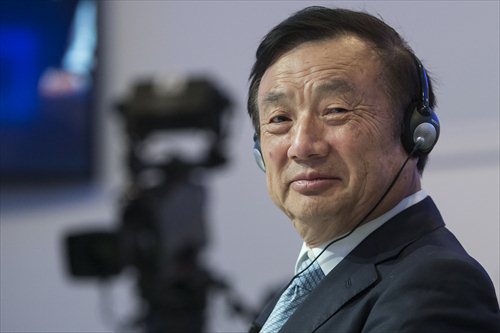HOME >> BUSINESS
Money + talent = breakthroughs for Huawei
By Li Xuanmin and Chen Qingqing Source:Global Times Published: 2016-6-2 23:58:01
Telecom leader vows to plow billions into R&D in coming years

Passengers pass by the advertisement boards of Huawei in a railway station in Guangzhou, capital of South China's Guangdong Province in May. Photo: IC

Ren Zhengfei, founder of Huawei. Photo: IC
Telecommunication equipment and service provider Huawei Technologies Co must beef up its research and development (R&D) effort to make technological breakthroughs and attract top talent, analysts said on Thursday.The comments came after CEO Ren Zhengfei called for innovation-driven corporate development and near-term technological breakthroughs. He made the comments in a speech at the national conference on science and technology, the biennial conference of the Chinese Academy of Sciences and Chinese Academy of Engineering and the national congress of the China Association for Science and Technology, held in Beijing on Monday.
Huawei has pledged to increase its annual R&D budget to $10 billion to $20 billion in the next few years, Ren noted. The company has more than 80,000 staff working on R&D, and 20 percent to 30 percent of its R&D budget goes to research and innovation and 70 percent to product development, he said.
In 2015, Apple and Google remained the two most innovative technology companies in the world, spending 14.9 percent and 3.3 percent of their revenue on R&D, respectively, PwC said in a global innovation study published in October 2015.
Apple's R&D budget was $6 billion in 2015 while Google spent $9.8 billion on R&D, the study estimated.
Huawei used to follow every step taken by telecommunication giant Ericsson. But now, Huawei is No.1 in this industry and a pace-setter for the telecommunication sector, Xiang Ligang, CEO of telecommunication industry portal cctime.com, told the Global Times on Thursday.
During his speech, Ren noted that Huawei is venturing into uncharted scientific areas, and it's urgent for the high-tech company, which has been working on engineering mathematics and physical algorithms, to accelerate efforts in basic theoretical study.
"Sometimes we're not even sure where our work is taking us," Ren said.
Technological barriers are probably the most demanding, Xiang stressed.
"Two basic theories … namely Mole and Shannon, which provide the foundations for the computer and communication industries separately, have been explored to their limits," Xiang said.
Only technological progress can shatter this barrier and sustain the continuous development of telecommunication industry, he said.
For example, the time delay in the communication process is a common issue, Xiang noted.
"A delay of 100 milliseconds won't be noticed when I am chatting on the phone with you. But the situation is quite different when you are using autonomous cars, which require instant signal transmissions with the control center," he said.
Huawei recorded revenue of 395 billion yuan ($60 billion) in 2015, up 37 percent year-on-year, according to an announcement on the company's website on April 1. Over the past 20-plus years, Huawei has focused on information and communications, steadily investing in R&D, the company said in the announcement.
In 2015 alone, Huawei invested 15 percent of its annual revenue - or 59.6 billion yuan - in R&D. Huawei's total R&D investment over the past decade exceeded 240 billion yuan, the company noted.
Ren also emphasized the importance of education and talent, according to his speech.
By working with technological talent from around the world, the company can generate annual revenue of $150 billion by 2020, Ren said during the conference.
The loss of talent due to skyrocketing property prices and living costs in major Chinese cities has undermined Huawei's R&D capacity, said Liu Dingding, a Beijing-based independent Internet industry analyst.
Talented people have creative ideas and produce innovative solutions. They are the key to sustaining Huawei's long-term development and profitability, experts said.
However, in the past few years, property prices in first-tier cities such as Shenzhen, South China's Guangdong Province, have soared beyond the purchasing power of many young innovators.
"Those young people have no choice but to leave Shenzhen, probably migrating to neighboring cities like Huizhou and Dongguan" in Guangdong Province, said Men Changhui, an analyst from Beijing-based CCID Consulting.
Posted in: Companies